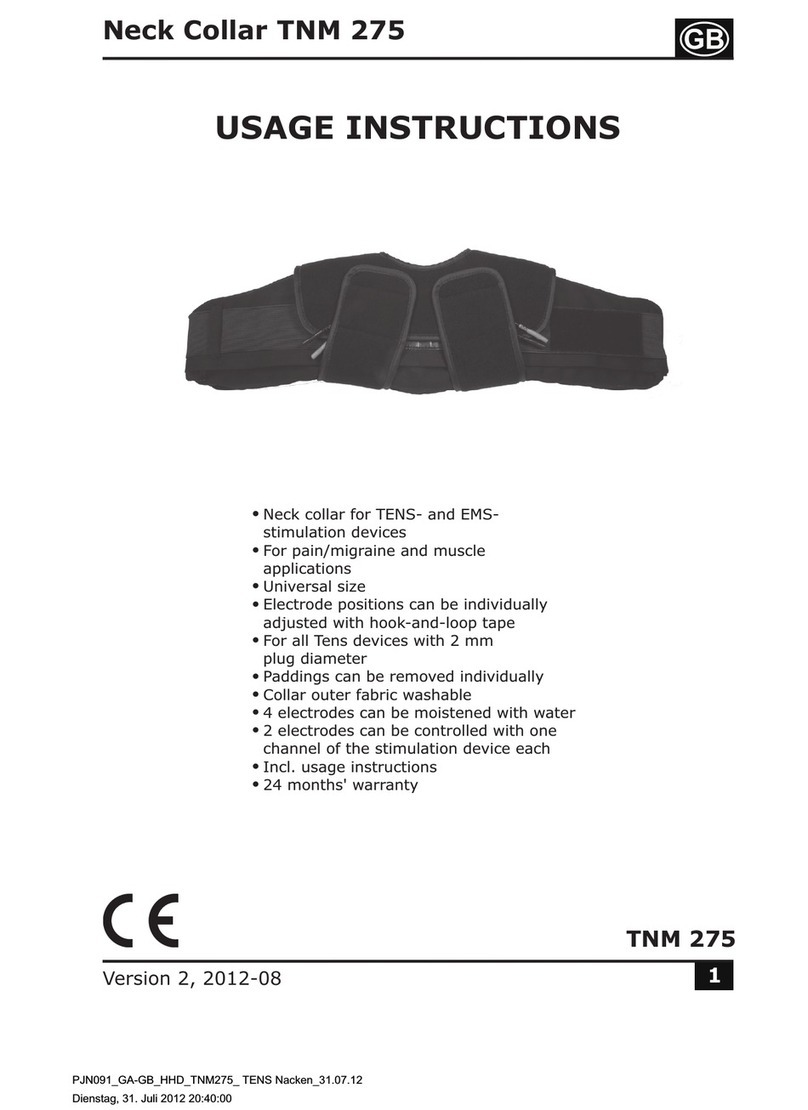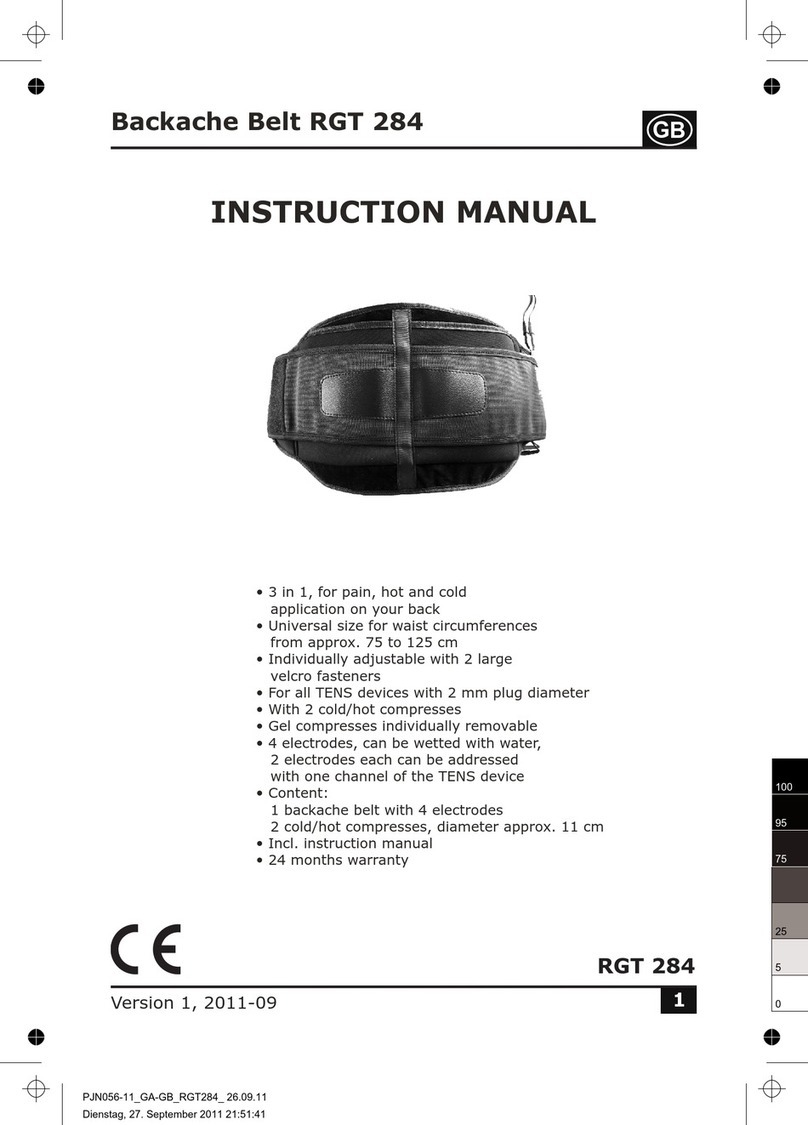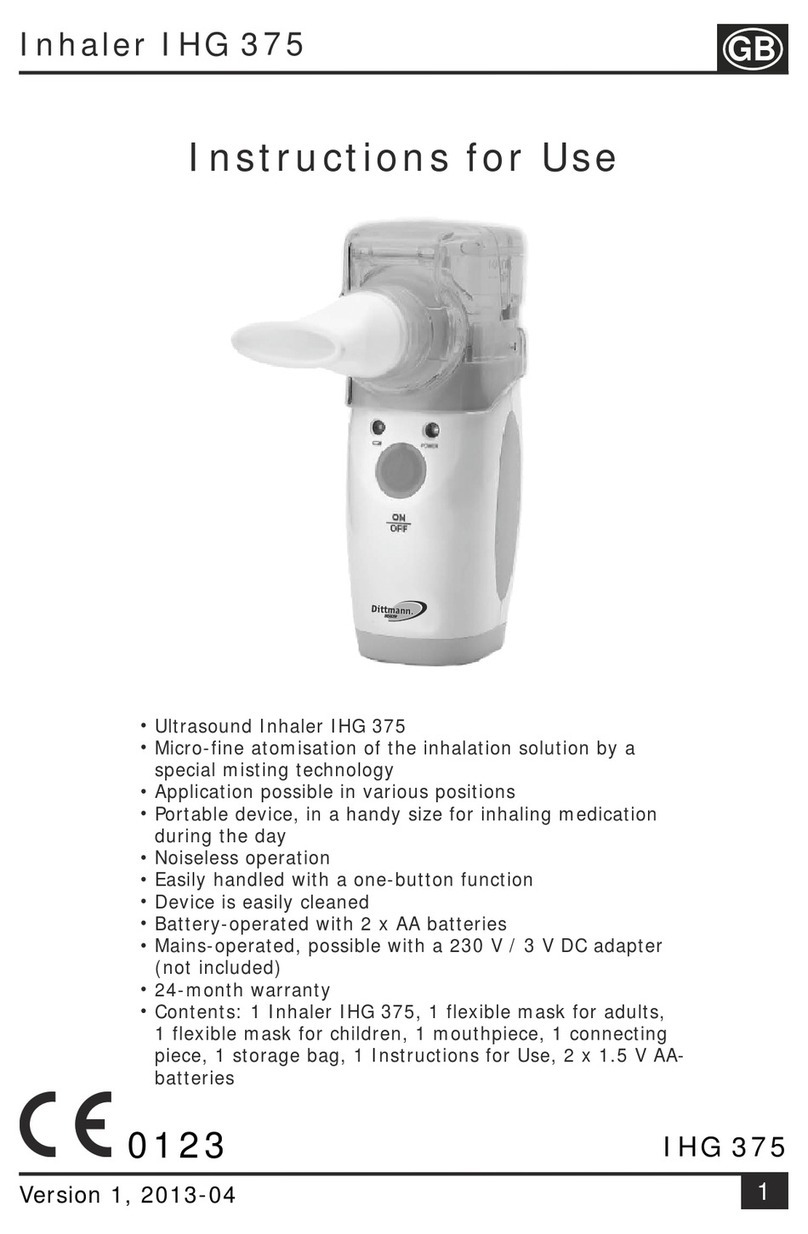Dittmann BSM 382 User manual

BSM 382
1
0123
Version 1, 2014-08
Precise and quick measurement of arterial
oxygen saturation on a finger
Pain-free measurement using two beams of
light with different wavelengths
Measurement and display of pulse rate and
pulse intensity as bar graph and wave diagram
(plethysmograph)
Quick and easy application
Easily portable thanks to low size and weight
Ideal for sports and leisure activities
24 month warranty
Contents: 1 Pulse Oximeter BSM 382
1 Operating manual, 2 x AAA batteries,
1 lanyard
OPERATING MANUAL
PULSE OXIMETER BSM 382
•
•
•
•
•
•
•
•
GB

2
5
6
6
7
8
9
10
10
11
13
13
16
16
16
17
18
19
1.0
2.0
2.1
2.2
2.3
2.4
3.0
3.1
3.3
3.4
3.5
4.0
4.1
4.2
4.3
5.0
6.0 Device front and LED display
Scope of supply/packaging content
Conditions that could influence the
measurement
Advantages of non-invasive pulse oximetry
What is pulse oximetry?
Questions regarding pulse oximetry
Important application information
Use by children and teenagers
Environmental restrictions of the BSM 382
unit
General safety information
Safety instructions
Intended use
Explanation of measurements
Pulse Oximeter BSM 382 fields of application
Application and operating principle
Application and function
Explanation of symbols
No. Topic Page
TABLE OF CONTENTS
GB

20
20
20
21
22
23
24
25
27
28
31
31
34
35
37
46
49
7.0
7.1
7.2
7.3
8.0
8.1
8.2
8.3
8.4
8.5
9.0
10.0
11.0
12.0
13.0
14.0
15.0
3
Warranty
Technical data
Information on electromagnetic immunity
Technical defects
Cleaning and care
Battery change and information
Device disposal
Pulse rate alarm settings
SpO2 alarm settings (oxygen saturation)
Activation/deactivation of the acoustic
function
Activation/deactivation of the alarm function
Display switching
Device operation
Lanyard attachment
Battery warning indicator
Inserting the batteries
Device commissioning
No. Topic Page
TABLE OF CONTENTS GB

4
In order to achieve precise and reliable
measurements, it is important to be familiar with
the operation of the device and information on
pulse oximetry. Please read this operating manual
carefully!
Pulse oximetry is a process for non-invasive
measurement of arterial blood oxygen saturation
as well as the pulse rate and pulse intensity on a
human finger. The oxygen saturation determined
in this way is referred to as SpO2 (saturation of
peripheral oxygen) and specifies the content of
haemoglobin saturated with oxygen in percent.
What is pulse oximetry?
Dear customer,
Thank you for purchasing a new Pulse
Oximeter BSM 382 and for your trust in
our products. To ensure proper functioning and
performance of your pulse oximeter, please read
the operating manual prior to using your device
for the first time. This is to ensure that you can
enjoy this article for a long time.
GENERAL INFORMATION
GB

5
ATTENTION: It is dangerous for users to carry
out self-diagnosis and self-treatment based on the
measurements determined with this Pulse
Oximeter BSM 382. This may lead to the
aggravation of diseases. This device can under no
circumstances replace proper medical consultation
- if in doubt, always consult your physician!
Device with type BF application part:
Protection against electrical shock by
means of leakage currents that conform
to standards.
These instructions must be complied
with!
Warning/Danger: Improper use leads
to a risk of severe injuries, damage and
danger of death!
Read and observe the operating manual!
The symbols have the following meanings:
The safety symbols illustrated in this operating
manual provide information on the proper use of
the device and to protect your safety.
1.0 Explanation of symbols
GENERAL INFORMATION GB

6
Photocell (infrared light receiver) Fig. 1
Infrared transmitter
The Pulse Oximeter BSM 382 is a portable
measuring device for easy, uncomplicated and
precise measurements of arterial oxygen
saturation as well as pulse rate and pulse intensity
(display as bar and wave chart) at any time. The
device features an adjustable acoustic and visual
alarm function.
Using the Pulse Oximeter BSM 382, the oxygen
saturation level of the arterial haemoglobin
(SpO2) can be easily measured on a finger. The
measurement is carried out by two light sources
with different wavelengths being shone through
the finger and hitting a photo electrode on the
other side. The photo electrode determines which
portions of the light have passed through the
finger. Depending on the blood oxygen saturation,
different portions of the light pass through the
finger. Based on these measurements, the device
determines the saturation level, making blood
samples unnecessary.
2.1 Application and operational principles
2.0 Application and function
GENERAL INFORMATION
GB

7
•
•
•
•
•
•
Private monitoring of oxygen saturation and
pulse levels
Sport aviation
Altitude training
Mountain climbing
Endurance training
Sports activities of any kind
Fields of application for the Pulse Oximeter BSM
382 for monitoring of oxygen saturation and pulse
levels may include:
This device is exclusively intended for private use.
It is not suitable for commercial application or
long-term monitoring.
2.2 Pulse Oximeter BSM 382 fields of
application
Principle of operation:
The Pulse Oximeter BSM 382 carries out two
measurements: Firstly, the blood oxygen
saturation and secondly, the pulse rate in the
finger tip. Additionally, the pulse intensity is
displayed as bar graph or wave diagram
(plethysmograph). For this purpose, the device is
clamped to a finger. Using infrared light, the
device can carry out measurements and assess
the colour deviation for different levels of blood
oxygen saturation to determine the current values.
Potential sources of errors due to external
influences include external infrared radiation, bad
circulation in the fingers and artificial or painted
finger nails.
GENERAL INFORMATION GB

8
•
•
•
•
•
•
•
•
Levels of blood oxygen saturation that are too
high may be caused by particularly quick and
deep breathing. The level may increase up to 100
per cent. However, this substantially reduces the
carbon dioxide content in the blood potentially
influencing the blood pH value balance. Breathing
air with an increased oxygen content (e.g. during
oxygen therapy) may also lead to increased levels.
Pulmonary emphysema
Asthma
Reduced respiration
Circulatory disturbance
Heart defect
Blood pH value disturbance
Low oxygen content in the ambient air
(e.g. in high-altitude mountains)
Increased oxygen consumption, e.g. through
physical exercise
For healthy people, a normal blood oxygen
saturation level of between 92 - 98 % is
measured. Diseases or conditions leading to blood
oxygen saturation levels that are too low
include:
2.3 Explanation of measurements
GENERAL INFORMATION
GB

9
This device must not be used by persons
(including children) with limited physical, sensory
or mental abilities or insufficient experience and/or
knowledge unless they are supervised by a person
responsible for their safety or have been
instructed on using the device.
The Pulse Oximeter BSM 382 is exclusively to be
used according to its intended use: measurement
of arterial oxygen saturation and pulse rate and
intensity on a human finger. The device is not
intended for long-term monitoring of patients!
The device is not equipped with an interface for
connection to other medical monitoring
equipment!
2.4 Intended use
GENERAL INFORMATION GB

3.1.1
3.1.2
3.1.3
3.1.4
3.1.5
3.1.6
3.1.7
3.1.8
3.1.9
10
Do not touch the device with pointed or
sharp objects.
To ensure precise measurements, protect
the device from dust, corrosive substances,
hot surfaces, humidity, dirt and damage.
Do not drop or shake the device and do not
expose it to shocks.
Misuse and use that does not conform with
the intended use of the device must be
prevented.
Keep this operating manual during the
service life of the product and pass it on
with the device if it is passed on to third
persons. Also make the operating manual
available to third persons. The operating
manual is an integral part of the device.
In case of any doubt concerning the
application of the device, please consult
your physician.
Do not carry out any other tasks during
measurement.
In case of irregularities during application of
the device, immediately stop using the
device and consult your physician.
The device must not be used in case of a
defect. Do not try to modify (change),
disassemble or repair the device or to
replace parts.
3.1 General safety instructions
3.0 Safety instructions
SAFETY INSTRUCTIONS
GB

3.2.0
3.2.1
3.2.2
3.2.3
3.2.4
11
3.3.1
3.3 Environmental restrictions of the
BSM 382
Do not use the device in humid or wet
environments or shortly after transferring it
from a cold to a hot and humid
environment. During application, keep away
the device away from any liquids and do not
immerse it in liquids at any time.
The device must not be disinfected with hot
steam or boiling water. For information on
disinfection, cleaning and care, please refer
to page 34.
Do not use or store the device in locations
with extremely high or low ambient
temperatures or in extremely dry or humid
environments as this may lead to inaccurate
measurements.
Remove the batteries from the device if it is
not used for longer periods of time to
prevent damage due to leaking batteries.
Do not open the device and do not try to
repair it in case of defects or damage. This
will result in voiding your warranty. The
device may only be repaired by authorised
specialists.
Do not expose the device to direct sunlight
or extremely high or low temperatures. Only
use and store the device in dry and clean
environments.
SAFETY INSTRUCTIONS GB

3.3.2
3.3.3
3.3.4
3.3.5
3.3.6
3.3.7
3.3.8
12
Medical electrical equipment is subject to
special safety requirements regarding EMC
(electromagnetic compatibility). Please note
the EMC instructions (page 37 - 45) for
installation and commissioning of the device.
When using the device, always observe a
safety distance of at least 1.5 m to
shortwave or microwave equipment or radio
frequency surgical instruments.
Do not use any mobile phones in the vicinity
of the device while carrying out
measurements. Please note that mobile RF
(radio frequency) communication equipment
(e.g. mobile phones) may disturb medical
electrical equipment.
During application, the device may cause
interferences for other electrical equipment.
Do not use it in the vicinity of other
electrical equipment.
The device must only be used in
environments free from dust, shocks,
vibrations and corrosive and flammable
substances.
WARNUNG - Risk of explosion! Do not use
the device in flammable atmospheres, with
flammable anaesthetics or other flammable
substances and gases or near explosive
substances!
The device must not be used during
magnetic resonance imaging or computer
tomography!
SAFETY INSTRUCTIONS
GB

3.4.1
3.4.2
3.4.3
3.4.4
3.5.1
3.5.2
3.5.3
13
WARNING: Do not look into the measuring
beam of the device. This could cause
damage to your eyes!
WARNING: The device must not be used
for long-term monitoring of patients (e.g.
in intensive care units)! The device is not
equipped with an interface for connection to
other medical monitoring equipment!
This pulse oximeter cannot replace medical
consultation or treatment! The
measurements are only to be used for
comparison. In case of health problems,
always seek medical consultation!
3.5 Important application
information
The device is not suitable for babies,
children under the age of 4 and for persons
weighing less than 15 kg!
Keep the device away from children. Small
parts or batteries may be swallowed and
lead to suffocation. Children may be injured
when using the device.
Supervise children to prevent them from
playing with the device.
Keep the device away from children and
teenagers under the age of 18.
3.4 Application by children and
teenagers
SAFETY INSTRUCTIONS GB

3.5.4
3.5.5
3.5.6
3.5.7
3.5.8
3.5.9
3.6.0
14
Do not attach the device to the same finger
for longer periods of time to prevent
pressure injuries. In case of pressure pain,
stop the application immediately. The
application on children and persons who
cannot make themselves understood as well
as persons with circulatory and sensory
disorders in the application area requires
special attention!
Do not use the device on wounds, skin rash,
fresh scars or painful areas.
The device requires approx. 8 seconds to
determine the measurement. Only
measurements that are properly displayed
are reliable. Fluctuating measurements are
not significant. For some persons, the device
cannot determine any reliable
measurements.
In case of unusually low measurements or
measurements that do not correspond to
your personal perception, repeat the
measurement. If in doubt, seek medical
consultation!
Regularly check the device for damage or
defects that could impair the safety and
functioning of the device.
Always keep the device clean and dry and
avoid damage. Only in this way can accurate
measurement results be ensured.
Do not use the device if it is damaged. Using
damaged devices may cause injuries,
serious danger and inaccurate
measurements.
SAFETY INSTRUCTIONS
GB

15
3.6.1
3.6.2
3.6.3
3.6.4
3.6.5
3.6.6
3.6.7
3.6.8
3.6.9 Measurements of the oxygen saturation in
the arterial haemoglobin may be influenced
by strong ambient lighting.
If the device displays unclear or fluctuating
values, remove the device from the finger
and reattach it to repeat the measurement.
The optical sensors of the device must be
protected from any contamination.
Contamination may lead to incorrect
measurements.
Make sure that there are no obstacles
between the measuring elements (optical
sensors) in the device.
Fingers that are too thin or too cold may
lead to incorrect measurements. In this
case, use the thumb and ensure that it is
inserted deeply enough into the device or
warm up the fingers.
Nail polish on the finger nails and nails that
are too long or artificial may make
measurements impossible or lead to
incorrect measurements.
Colour on the fingers (dirt, tattoos) may
lead to incorrect measurements.
Before carrying out any measurements with
the device, make sure that the fingers are
clean, dry and oil-free.
Stop using the device in case of intolerance
or allergic reactions (e.g. latex allergy)
caused by components o f the device.
SAFETY INSTRUCTIONS GB

16
The measurement of the arterial oxygen saturation
level using the Pulse Oximeter BSM 382 is
uncomplicated, non-invasive (no blood sample
needs to be taken) and can be carried out almost
everywhere at any time due to the small size and
low weight of the device. Another advantage is
that pulse rate and pulse intensity are
simultaneously determined and displayed. The
Pulse Oximeter BSM 382 can be extremely useful,
particularly for activities that may lead to
deterioration in arterial blood oxygen saturation
(mountain climbing, aviation, hang gliding,
paragliding, endurance sport, etc.) but also for
private checks and during sports and leisure
activities of any kind.
4.2 Advantages of non-invasive
pulse oximetry
Pulse oximetry enables non-invasive
measurements of arterial oxygen saturation as
well as pulse rate and pulse intensity. The
measurement is carried out by two light sources
with different wavelengths (660 nm red light and
940 nm infrared light) which are shone through
the finger and hit a photo electrode on the other
side determining the potions of the light that have
passed through the finger. Depending on the blood
oxygen saturation, different portions of the light
pass through the finger. Based on these
measurements, the device determines the
saturation level.
4.1 What is pulse oximetry?
4.0 Questions regarding pulse oximetry
PULSE OXIMETRY
GB

17
4.3.1
4.3.2
4.3.3
4.3.4
4.3.5
4.3.6
4.3.7
4.3.8 Incorrect measurements may occur due to
severe hypothermia, shock and low blood
pressure as well as poisoning which
influences the oxygen binding capacity of
the haemoglobin.
For patients suffering from severe anaemia
or anaemic or toxic oxygen deficiency, the
measurements may be incorrect.
Medication such as dopamine, procaine,
lidocaine and butacaine may strongly
influence the measurement.
Strong ambient lighting from fluorescent
lamps, infrared lamps and heating devices
or direct sunlight is to be avoided.
No arterial or venous lines must be
connected to the arm of the finger which the
measurement is being carried out on and no
blood pressure cuffs may be used.
The finger used for measurement must not
be moved and the person who the
measurement is being carried out must stay
calm.
The finger must be inserted deeply enough
into the device with the finger nail pointing
upwards to the display side of the device.
There must be no dirt, nail polish or tattoos
on the finger or finger nail.
Please observe the following circumstances as
these may influence the measurement or lead to
incorrect measurements:
4.3 Conditions that could influence
the measurement
PULSE OXIMETRY GB

18
Please check all components directly after
unpacking for completeness of the scope of
delivery and damage.
Do not use the device in case of damage or if the
operating manual is missing!
2 x AAA batteries
1 x Operating manual
1 x Pulse Oximeter BSM
382 i
5.0 Scope of supply
(packaging content)
SCOPE OF SUPPLY
GB
1 x Lanyard

1.
2.
3.
4.
5.
6.
7.
8.
9.
19
1
2
3
9
8
4
5
666
7
ON/OFF button for activation or manual
deactivation of the measurement process
Mconfiguration button for display switching
and setting visual and acoustic alarms
Colour display (OLED display)
Battery compartment at the back of the device
Battery symbol / warning indicator ( ) in
case of low batteries
Pulse rate display
Pulse intensity display as pulse chart
(plethysmograph)
Pulse intensity display as bar graph
Display of the measured arterial oxygen
saturation level (%SpO2)
6.0 Device front and LED display
DEVICE FRONT / LED DISPLAY GB

20
5
If the batteries of the device are low, the battery
symbol ( ) only displays one bar. In this
case, please insert new batteries (also refer to
point 10.0 on pages 31 - 33).
7.2 Battery warning indicator
Fig. 2
Press on the arrow-shaped surface on the battery
compartment cover on the back of the device and
slide the cover off. Insert 2 batteries (type AAA) in
the correct position (+ and - pole) according to
the marking in the centre of the battery
compartment (refer to fig. 2). WARNING: Make
sure that the batteries are inserted correctly
according to their polarity! Incorrectly inserted
batteries may damage the device! Afterwards,
reattach the battery compartment cover by sliding
it until it locks in place and closes flush with the
device housing.
Battery types: The Pulse Oximeter BSM 382
requires alkaline batteries type AAA. Do not use
rechargeable batteries!
7.1 Inserting the batteries
7.0 Starting up the device
GETTING STARTED
GB
Table of contents
Other Dittmann Medical Equipment manuals
Popular Medical Equipment manuals by other brands

Getinge
Getinge Arjohuntleigh Nimbus 3 Professional Instructions for use

Mettler Electronics
Mettler Electronics Sonicator 730 Maintenance manual

Pressalit Care
Pressalit Care R1100 Mounting instruction

Denas MS
Denas MS DENAS-T operating manual

bort medical
bort medical ActiveColor quick guide

AccuVein
AccuVein AV400 user manual
















